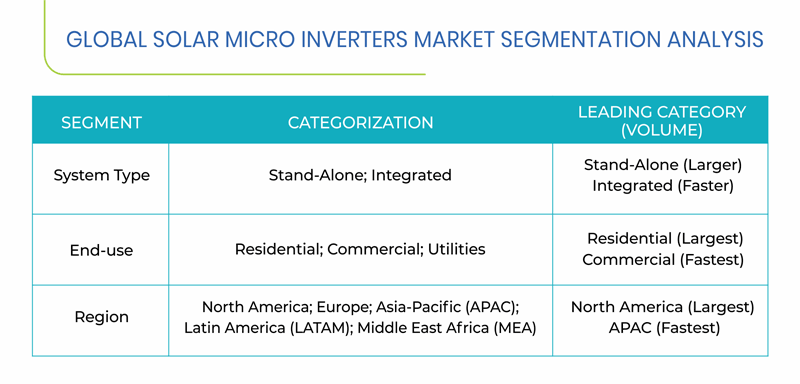Solar Micro Inverters Market to Generate Revenue Worth $1,968.7 Million by 2026
- Published: March 2017
The global solar micro inverters market was valued at $431.6 million in 2015 and is projected to reach $1,968.7 million by 2026, progressing at a CAGR of 15.3% during the forecast period (2016–2026). The residential category in terms of end use held the largest revenue share in the market during the historical period (2012–2015).
Historically, the industry witnessed the fastest growth in the commercial category. The market growth in this category is mainly driven by increase in installations of commercial solar photovoltaic (PV) panels and decrease in the micro inverter prices.
Growing Focus Toward Integrated Module Systems Is a Major Trend
The major trend witnessed in the global solar micro inverters market is the growing focus toward integrated module systems. The high-performance integrated module systems also known as AC modules are designed to meet the increasing electricity demand and minimize the installation time. These modules offer up to 25% more power than conventional systems.
Increasing demand for Micro Inverters Drives the Market
Drop in the prices of micro inverter and increasing government initiatives have resulted an increase in the adoption of PV installations. Solar micro inverters have larger number of PV installations in the residential sector, owing to their optimal performance and affordability. Adoption of micro inverters is gaining traction in developing nations including Asia-Pacific due to burgeoning demand for power supply, and increasing fuel prices.
Segmentation Analysis of Solar Micro Inverters Market

The stand-alone system category led the solar micro inverters market in 2015. This is attributed to the lower price of the stand-alone system as compared to the integrated system.
The commercial category in terms of end use is expected to exhibit the fastest revenue growth during the forecast period. This can be ascribed to increase in commercial solar PV installations and decrease in the micro inverter prices.
Geographical Analysis of Solar Micro Inverters Market
North America and Europe are expected to account for over 70% share in the global solar micro inverters market by 2026. This can be mainly attributed to the large number of residential PV installations and strong government initiatives favouring solar PV systems.
APAC, LATAM, and MEA also hold considerable shares in market, on account of increasing demand for power supply, substantial reduction in the costs of micro inverters, and government support.
Japan is expected to lead the APAC solar micro inverters market, generating revenue of over $113.1 million in 2026. This can be mainly attributed to increasing PV installations in residential sector on account of improvement in renewable energy.
Brazil is the fastest-growing market for solar micro inverters in the LATAM region. Rising electricity demand and the high irradiation levels in the country are the major factors contributing to the growth of the market in Brazil.
Improvements in the legal framework for solar PV systems, unreliable power supply, and frequent rise in the electricity prices have led to an increase in the solar PV installations in South Africa. South Africa is expected to hold a considerable share in the MEA solar micro inverters market during the forecast period.
Competitive Landscape of Solar Micro Inverters Market
In January 2017, Altenergy Power System Inc. announced plans to enter into the partnership with Sungage Financial. With this partnership, Altenergy will cater the demand from national solar installers for APsystems powerful residential solar microinverters.
Some of the key players operating in the solar micro inverters market are Enphase Energy Inc., SolarEdge Technologies Inc., SMA Solar Technology AG, Altenergy Power System Inc., and Northern Electric and Power Co. Ltd.